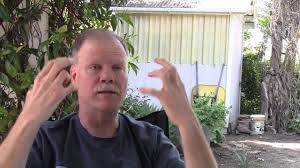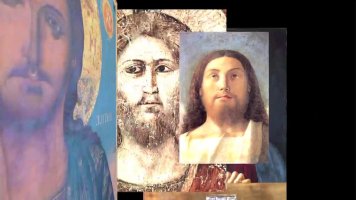
Greg Spencer of Roseburg, OR, was a police offer in narcotics enforcement in the 1990s. His work kept him immersed in a world of violence, death, and depravity on a regular basis. In addition he was a deputy medical examiner, which meant he had to view autopsies, often on bodies whose life had ended in a horrible death. He was dedicated to his work, but it turned him into a hardened and calloused man, and his first marriage ended because of it.
He left the police force after fifteen years of service and became a cross-country truck driver, but about six months into that, macular degeneration in both eyes rendered him effectively blind. He went on disability, and, with the expectation of being blind and disabled for the rest of his life, got help through the Oregon Commission of the Blind in functional blind living, including white cane and guide dog training.
During this time, he met Wendy – his face softens into a smile when he mentions Wendy – a “born again, on fire believer in Jesus Christ,” who “drug me with her to church.” He met Jesus Christ there. And he married Wendy.
If Greg Spencer’s story were to end there, most of us would consider it a rather happy ending. A man loses his sight but gains salvation, a beautiful wife, and the means to live out a reasonably comfortable life on earth. But his story didn’t end there.
Healed
In 2001, he attended a men’s retreat, the topic of which was, “Cleansing of the Mind.” He needed that. He’d not been able to sleep nights because of the horrid, graphic images of bodies, violence, and pornography still haunting his psyche. Sometimes he would wake up screaming from the nightmares.
So at the retreat he prayed,
Lord, cleanse my mind. Take this junk away. Set me free. Right away, he felt the Lord respond directly,
You’re clean.
He opened his eyes. And the next thing he knew, he was reading the little red “Exit” sign behind the speaker in the chapel. Not only had his mind been cleansed of the residue of years among such evil, but his eyes had been healed of their blindness. His vision was totally restored. Even the scar tissue was gone.
A subsequent investigation opened by the state of Oregon resulted in comprehensive documentation, both of his visual impairment and the restoration of his sight, and cleared him of any fraud charges in relation to the temporary collection of disability. His is a current-day, thoroughly documented healing, or in the words on the diagnosis submitted by Dr. Brad Seeley of the Dept. of Ophthalmology, Oregon Health Sciences University, “Unexplained Decreased Visual Acuity.”
 The Testimony of Data
The Testimony of Data
Greg Spencer’s story is only one small component of the documentary,
Jesus of Testimony, produced by Nesch Productions, but it offers our scientifically “enlightened” age some powerful evidence of the supernatural to chew on.
Though this story is dramatic, most of the two-plus hour long documentary is more of an intellectual discussion with an array of New Testament scholars. Here’s a brief summary:
Part One: Lord or Legend looks at references to Jesus from sources outside the Bible – for example the Roman historian Tacitus and Josephus, an ancient Jewish scholar – that confirm details in the gospel accounts. For example, many non-Christian sources didn’t shy away from calling Jesus “God” or “Son of God.” Some mention that he was known for miracles, even by those who didn’t believe in him. Thallus, a Greek historian, wrote of the darkness on Good Friday, and Josephus tells about the resurrection.
Part Two: Are the Gospels Reliable? gives data on the numbers of extant manuscripts, full and partial, to address the question,
Are the gospel texts we have today reliable copies of the originals? It also looks at ancient customs concerning oral traditions and the dating of the writings.
Part Three: Miracles, which is the segment containing the story of Greg Spencer, deconstructs David Hume’s circular argument against the possibility of miracles, on which most arguments against miracles are based today and explains how the empirical sciences, historiography, and forensics go about (or at least
should go about) evaluating claims concerning the miraculous.
Part Four: The Testimony of Prophecy. The Old Testament contains more than three hundred prophecies about the coming Messiah. All were fulfilled in Jesus Christ. This segment draws out a few of them, establishing the supernatural credentials both of the ancient prophets and of Jesus himself.
Part Five: The Resurrection – Fact or Fiction? looks at the practice of crucifixion (a highly reliable means of killing, which the Romans both invented and perfected), the evidence for the empty tomb, and the various theories posited to explain the resurrection away.
Part Six: The Good News gives us the basic New Testament gospel message, and then we hear from two men. Dr. Michael Brown, who says his own story is “from LSD to Ph.D.,” shot heroin and played drums in a rock band with the intention of becoming a rock star until the day he realized how much God loved him and that Jesus had died for him. On that day, he says, God set him free, and he never put a needle in his arm again. Dr. Brown went on to earn a PhD in Near Eastern Languages and Literatures. He is the author of numerous books including
Answering Jewish Objections to Jesus: Messianic Prophecy Objections.
Dr. Craig Keener was an atheist when some people shared the gospel with him. He said, “I’m an atheist; I don’t believe that. Why should I believe that?” and then walked away.
But although they couldn’t give him a good argument for it, they did give him the right content, and after that, God gave him a different kind of evidence. “God gave me the evidence of his own presence,” he says, knowing that some people may not be able to understand that. It was “a certainty that went beyond any other kind of evidence that I could have had because it came directly into my heart.” He didn’t understand the language of salvation that the people had used, and he struggled with God over the implications of it. But eventually his knees buckled underneath him and he surrendered. That was the beginning of his Christian life.
The Testimonies of the Living
Jesus of Testimony is packed with data about this one central figure of human history, Jesus of Nazareth. The information could have been put into book form, but there’s something more human about hearing the scholars speak to it, especially the ones whose lives have undergone such drastic transformations. Greg Spencer didn’t ask God to restore his sight.
Dr. Michael Brown didn’t ask for help getting off drugs, and Dr. Craig Keener never asked to be “cured” of his atheism.
The data is compelling on its own. The evidence in human lives, the testimonies of men whose lives have been restored, changed, retooled, if you will, for
good rather than for
naught, is soul-nourishing. If the historical Jesus of testimony is who he told us he was, this should come as no surprise whatsoever.
Craig Keener, who now teaches at at Asbury Theological Seminary and is the author of numerous books including,
Miracles: The credibility of the New Testament Accounts, has a message for anyone who’ll listen: “If God would take me, … who had blasphemed God’s name, who had spoken against him, if God would take me, God will take anybody who’s just willing to accept the testimony of the Spirit. Jesus rose from the dead, and now Jesus is alive and is Lord of the universe and is ready to transform the life of whoever comes to him.”




